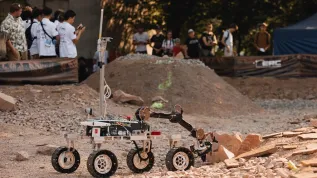![Źródło: MarekMiś [CC BY 4.0] via Wikimedia Commons](/sites/default/files/styles/strona_glowna_slider_750x420/public/202001/800px-Rodza%CC%A8ca_dafnia.jpg.webp?itok=J3Z1xLD_)
An incredible photo of Daphnia giving birth has won the Polish edition of the Wiki Science Competition 2019.
The stunning photo of the genus of small planktonic crustaceans commonly called water fleas was captured by Marek Miś who picked up prize money of PLN 1,600.
In the competition, the jury evaluated photos shared on Wikipedia, documenting the world of science: objects and results of research, scientists at work and research equipment.
Commenting on Miś’s ‘Birthing Daphina’, the jury said: “The work focuses on all aspects of good science photography: it is technically correct and clearly presents the recorded subject. At the same time, it is presented in a beautiful palette of colours and, which secured the win, presents an extraordinary moment: the birth of the young - which fits perfectly into the +The decisive moment+ concept of photography.”
The 2nd prize in the competition and PLN 1,000 went to Adrianna Rafalska for her photograph `Grape wood borer (Chlorophorus varius)’. The jury praised the capture saying: “The photograph is characterized by the excellent location of the focus plane, which focuses the eye on the insect`s head, and thanks to the resolution of the photo it allows to analyse its individual elements. It remains poetic, while the anthropomorphizing +gesture of covering with petals+ and a pastel range of colours encourages the recipient to explore the microcosm of nature.”
Third place and PLN 800 went to Jan Ozimek`s photo `Growing razors: inorganic layer growing on biomaterial`. The jury said: “The work shows not only the effect of work on the latest technologies at the nano scale, but also addresses the issue of visibility: the image is created as a result of recording electrons and not photons (visible light), and yet thanks to algorithmic processing it was presented to us as a visible, colourful picture of the world from outside the range of our senses.”
Over 1300 photographs were submitted to the competition.
A special distinction was awarded to Wojciech Kocot, a new Wikipedia user, for a particularly large number (334) of good quality and content photographs submitted for the competition.
The jury also granted special awards to several photos, including colourful microscopic images of crystal structures, photos of animals in their natural environment, as well as a bioart work.
The competition results are available on Wikimedia Commons.
PAP - Science in Poland
lt/ agt/ kap/
tr. RL
Gallery (19 images)
-
![Źródło: MarekMiś [CC BY 4.0] via Wikimedia Commons](/sites/default/files/styles/juicebox_medium/public/202001/800px-Rodza%CC%A8ca_dafnia_0.jpg.webp?itok=M_BQ_V0G) 1/19Źródło: MarekMiś [CC BY 4.0] via Wikimedia Commons
1/19Źródło: MarekMiś [CC BY 4.0] via Wikimedia Commons -
![Źródło: MarekMiś [CC BY 4.0] via Wikimedia Commons](/sites/default/files/styles/juicebox_medium/public/202001/800px-Bosmina_i_Sida_crystallina_0.jpg.webp?itok=FePsGxiM) 2/19Źródło: MarekMiś [CC BY 4.0] via Wikimedia Commons
2/19Źródło: MarekMiś [CC BY 4.0] via Wikimedia Commons -
![Źródło: Adrianna Rafalska [CC BY 4.0] via Wikimedia Commons](/sites/default/files/styles/juicebox_medium/public/202001/800px-Green_Immigrant_Leaf_Weevil_%28Polydrusus_formosus%29_0.jpg.webp?itok=mspRgsCw) 3/19Źródło: Adrianna Rafalska [CC BY 4.0] via Wikimedia Commons
3/19Źródło: Adrianna Rafalska [CC BY 4.0] via Wikimedia Commons -
![Źródło: Salicyna [CC BY 4.0] via Wikimedia Commons](/sites/default/files/styles/juicebox_medium/public/202001/800px-Tenthredo_amoena_2019-09-22_4392_0.jpg.webp?itok=6wld71rP) 4/19Źródło: Salicyna [CC BY 4.0] via Wikimedia Commons
4/19Źródło: Salicyna [CC BY 4.0] via Wikimedia Commons -
![Źródło: MarekMiś [CC BY 4.0] via Wikimedia Commons](/sites/default/files/styles/juicebox_medium/public/202001/800px-Wios%CC%81larka_Simocephalus.jpg.webp?itok=sO33sGMV) 5/19Źródło: MarekMiś [CC BY 4.0] via Wikimedia Commons
5/19Źródło: MarekMiś [CC BY 4.0] via Wikimedia Commons -
![Źródło: Hzofia74 [CC BY 4.0] via Wikimedia Commons](/sites/default/files/styles/juicebox_medium/public/202001/1024px-Effect_of_a_constant_magnetic_field_0.jpg.webp?itok=qA-EHvjs) 6/19Źródło: Hzofia74 [CC BY 4.0] via Wikimedia Commons
6/19Źródło: Hzofia74 [CC BY 4.0] via Wikimedia Commons -
![By Jan Ozimek [CC BY 4.0] via Wikimedia Commons](/sites/default/files/styles/juicebox_medium/public/202001/1024px-Growing_razors_01_inorganic_layer_growing_on_biomaterial_0.jpg.webp?itok=Em3fMxb7) 7/19By Jan Ozimek [CC BY 4.0] via Wikimedia Commons
7/19By Jan Ozimek [CC BY 4.0] via Wikimedia Commons -
![Źródło: Krzysztof Ziarnek, Kenraiz [CC BY 4.0] via Wikimedia Commons](/sites/default/files/styles/juicebox_medium/public/202001/1024px-Psathyrella_ammophila_kz01_0.jpg.webp?itok=1J59q95o) 8/19Źródło: Krzysztof Ziarnek, Kenraiz [CC BY 4.0] via Wikimedia Commons
8/19Źródło: Krzysztof Ziarnek, Kenraiz [CC BY 4.0] via Wikimedia Commons -
![Źródło: MarekMiś [CC BY 4.0] via Wikimedia Commons](/sites/default/files/styles/juicebox_medium/public/202001/1280px-1-ASCORBIC_ACID_0.jpg.webp?itok=wpNtGKy0) 9/19Źródło: MarekMiś [CC BY 4.0] via Wikimedia Commons
9/19Źródło: MarekMiś [CC BY 4.0] via Wikimedia Commons -
![Źródło: Adrianna Rafalska [CC BY 4.0] via Wikimedia Commons](/sites/default/files/styles/juicebox_medium/public/202001/1280px-Chlorophorus_varius_0.jpg.webp?itok=UBDfjKfO) 10/19Źródło: Adrianna Rafalska [CC BY 4.0] via Wikimedia Commons
10/19Źródło: Adrianna Rafalska [CC BY 4.0] via Wikimedia Commons -
![Źródło: MarekMiś [CC BY 4.0] via Wikimedia Commons](/sites/default/files/styles/juicebox_medium/public/202001/1280px-Draparnaldia_0.jpg.webp?itok=MTxIRMwY) 11/19Źródło: MarekMiś [CC BY 4.0] via Wikimedia Commons
11/19Źródło: MarekMiś [CC BY 4.0] via Wikimedia Commons -
![Źródło: Fundacja Badań i Rozwoju Nauki [CC BY 4.0] via Wikimedia Commons](/sites/default/files/styles/juicebox_medium/public/202001/1280px-Formation_of_the_new_blood_vessels_2_0.jpg.webp?itok=8PXH6Ds_) 12/19Źródło: Fundacja Badań i Rozwoju Nauki [CC BY 4.0] via Wikimedia Commons
12/19Źródło: Fundacja Badań i Rozwoju Nauki [CC BY 4.0] via Wikimedia Commons -
![Źródło: PanWoyteczek [CC BY 4.0] via Wikimedia Commons](/sites/default/files/styles/juicebox_medium/public/202001/1280px-Is03188-Owca_0.jpg.webp?itok=N-hJhhtz) 13/19Źródło: PanWoyteczek [CC BY 4.0] via Wikimedia Commons
13/19Źródło: PanWoyteczek [CC BY 4.0] via Wikimedia Commons -
![Źródło: PanWoyteczek [CC BY 4.0] via Wikimedia Commons](/sites/default/files/styles/juicebox_medium/public/202001/1280px-Is09074-Go%CC%81ry_Te%CC%A8czowe.jpg.webp?itok=Vct12nxo) 14/19Źródło: PanWoyteczek [CC BY 4.0] via Wikimedia Commons
14/19Źródło: PanWoyteczek [CC BY 4.0] via Wikimedia Commons -
![Źródło: MarekMiś [CC BY 4.0] via Wikimedia Commons](/sites/default/files/styles/juicebox_medium/public/202001/1280px-Kwas_askorbinowy_0.jpg.webp?itok=NBDXDzsV) 15/19Źródło: MarekMiś [CC BY 4.0] via Wikimedia Commons
15/19Źródło: MarekMiś [CC BY 4.0] via Wikimedia Commons -
![Źródło: PanWoyteczek [CC BY 4.0] via Wikimedia Commons](/sites/default/files/styles/juicebox_medium/public/202001/1280px-SA05324-Guziec_0.jpg.webp?itok=hqBjQaww) 16/19Źródło: PanWoyteczek [CC BY 4.0] via Wikimedia Commons
16/19Źródło: PanWoyteczek [CC BY 4.0] via Wikimedia Commons -
![Źródło: PanWoyteczek [CC BY 4.0] via Wikimedia Commons](/sites/default/files/styles/juicebox_medium/public/202001/1280px-SA15259-Z%CC%87uk_Gnojarek.jpg.webp?itok=BNBy65hg) 17/19Źródło: PanWoyteczek [CC BY 4.0] via Wikimedia Commons
17/19Źródło: PanWoyteczek [CC BY 4.0] via Wikimedia Commons -
![Źródło: Adrianna Rafalska [CC BY 4.0] via Wikimedia Commons](/sites/default/files/styles/juicebox_medium/public/202001/1280px-Spontaneous_mutation_of_Schmidtea_meditteranea_0.jpg.webp?itok=AUjEENnb) 18/19Źródło: Adrianna Rafalska [CC BY 4.0] via Wikimedia Commons
18/19Źródło: Adrianna Rafalska [CC BY 4.0] via Wikimedia Commons -
![Źródło: Adrianna Rafalska [CC BY 4.0] via Wikimedia Commons](/sites/default/files/styles/juicebox_medium/public/202001/1280px-Viviparous_Lizard_Zootoca_vivipara_0.jpg.webp?itok=7wCKJEb6) 19/19Źródło: Adrianna Rafalska [CC BY 4.0] via Wikimedia Commons
19/19Źródło: Adrianna Rafalska [CC BY 4.0] via Wikimedia Commons













